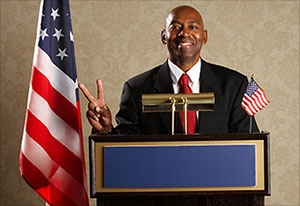Social Studies

What is a political campaign? A campaign is simply an attempt by a candidate to win an elected office, often backed by a political party at the state and federal levels. There are many factors and influences that go on behind the scenes of a campaign and affect the way a candidate will pursue the office he seeks.
Candidates run campaigns to help the public get to know them and their platform. Running a campaign requires a staff, which can vary in size from campaign to campaign. Some staffers include:
- The campaign managers coordinates the entire campaign. He or she develops and executes the campaign plan
- The Finance chair is responsible for raising money to fund the campaign
- Issue advisers educate the candidate and write campaign position papers on major issues important to the voting public
- Scheduler manages the candidate's time to ensure that he or she attends the events necessary for a successful campaign.
Staff members need to identify how and where they can make sure their candidate wins. Knowing this ahead of time helps a campaign develop and deliver their candidate's message. A large part of creating a winning message is to know who will want to hear it, mainly by conducting polls and determining who is likely to vote for the candidate. Likewise, targeting the message to this select group of people is essential. Campaigns often use focus groups, small gatherings of people whose response to something is studied and used to predict the response of a larger population. Once a campaign staff knows how people feel about the candidate and the platform, they can adjust the candidate's image and create advertisements geared toward these feelings.
Presidential candidates will often spend more time in states with
- Several electoral votes
- Sates where support for opponents is weak
- Swing states-those states where support for each candidate is about equal.
Sometimes campaigns involve negative campaigning. When employing this strategy, a candidate attacks an opponent in hopes of decreasing his or her support and forcing the opponent to spend time and energy responding to the attack.
Advertisements aimed at the correct demographic as well as the use of sound bites, or brief segments of speeches or statements, are critical in pushing a candidates "image" to the proper voters.




